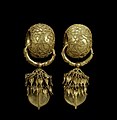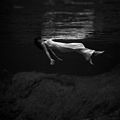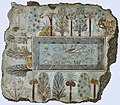Portal:The Arts
The arts or creative arts are a vast range of human practices of creative expression, storytelling, and cultural participation. The arts encompass diverse and plural modes of thinking, doing, and being in an extensive range of media. Both dynamic and a characteristically constant feature of human life have developed into stylized and intricate forms. This is achieved through sustained and deliberate study, training, or theorizing within a particular tradition, generations, and even between civilizations. The arts are a vehicle through which human beings cultivate distinct social, cultural, and individual identities while transmitting values, impressions, judgements, ideas, visions, spiritual meanings, patterns of life, and experiences across time and space. (Full article...)
Featured articles -

KNXV-TV (channel 15) is a television station in Phoenix, Arizona, United States, affiliated with ABC. It was established in 1979 as the Phoenix area's second independent station with part-time subscription television programming from ON TV. It was originally owned by the New Television Corporation, which had attempted to set up the station for nearly five years prior to its launch. In 1985, Scripps-Howard Broadcasting, the broadcast division of the E. W. Scripps Company, acquired KNXV-TV. Channel 15 affiliated with Fox in 1986 and became the leading independent in the market, one of Fox's strongest affiliates. In 1994, Fox announced a multi-city affiliation agreement with New World Communications which included Phoenix's then-CBS affiliate, KSAZ-TV, and mostly CBS affiliates in several other major markets. CBS expressed interest in affiliating with Scripps's ABC affiliates in other cities and Scripps used this as leverage to force ABC to move its Phoenix affiliation from market leader KTVK to KNXV-TV beginning in January 1995. (Full article...)
Catherine de' Medici (Italian: Caterina de' Medici, pronounced [kateˈriːna de ˈmɛːditʃi]; French: Catherine de Médicis, pronounced [katʁin də medisis]; 13 April 1519 – 5 January 1589) was an Italian (Florentine) noblewoman born into the Medici family. She was Queen of France from 1547 to 1559 by marriage to King Henry II and the mother of French kings Francis II, Charles IX, and Henry III. The years during which her sons reigned have been called "the age of Catherine de' Medici" since she had extensive, albeit at times varying, influence on the political life of France. (Full article...)

The construction of the Rockefeller Center complex in Midtown Manhattan, New York City, was conceived in the late 1920s and led by John D. Rockefeller Jr.. Rockefeller Center is on one of Columbia University's former campuses and is bounded by Fifth Avenue to the east, Sixth Avenue (Avenue of the Americas) to the west, 48th Street to the south, and 51st Street to the north. The center occupies 22 acres (8.9 ha) in total, with some 17 million square feet (1.6 million square meters) of office space. (Full article...)

Portrait of a Lady (or Portrait of a Woman) is a small oil-on-oak panel painting executed around 1460 by the Netherlandish painter Rogier van der Weyden. The composition is built from the geometric shapes that form the lines of the woman's veil, neckline, face, and arms, and by the fall of the light that illuminates her face and headdress. The vivid contrasts of darkness and light enhance the almost unnatural beauty and Gothic elegance of the model. (Full article...)
Harold Pinter CH CBE (/ˈpɪntər/; 10 October 1930 – 24 December 2008) was a British playwright, screenwriter, director and actor. A Nobel Prize winner, Pinter was one of the most influential modern British dramatists with a writing career that spanned more than 50 years. His best-known plays include The Birthday Party (1957), The Homecoming (1964) and Betrayal (1978), each of which he adapted for the screen. His screenplay adaptations of others' works include The Servant (1963), The Go-Between (1971), The French Lieutenant's Woman (1981), The Trial (1993) and Sleuth (2007). He also directed or acted in radio, stage, television and film productions of his own and others' works. (Full article...)
Rhythm Killers is an album by Jamaican musical duo Sly and Robbie, released in May 1987 by Island Records. By the time of the album's recording, Sly and Robbie had transitioned away from their prolific work in the reggae genre. They spent the 1980s experimenting with electronic sounds and contemporary recording technology on international, cross-genre endeavors, which influenced their direction for Rhythm Killers. (Full article...)
The Old Church of St Nidan, Llanidan is a medieval church in the community of Llanidan, in Anglesey, North Wales, close to the Menai Strait. The first church on the site was established in the 7th century by St Nidan, the confessor of the monastery at Penmon, Anglesey, but the oldest parts of the present structure, now closed and partly ruined, date from the 14th century. In about 1500 the church was enlarged by the addition of a second nave on the north side, separated from the earlier nave by an arcade of six arches. During 1839 till 1843 a new church was built nearby to serve the local community, partly due to the cost of repairing the old church. Much of the building was subsequently demolished, leaving only part of the western end and the central arcade. The decision was condemned at the time by Harry Longueville Jones, a clergyman and antiquarian, who lamented the "melancholy fate" of what he called "one of the largest and most important [churches] in the island of Anglesey". Other appreciative comments have been made about the church both before and after its partial demolition. (Full article...)
Ghostbusters is a 1984 American supernatural comedy film directed by Ivan Reitman and written by Dan Aykroyd and Harold Ramis. It stars Bill Murray, Aykroyd, and Ramis as Peter Venkman, Ray Stantz, and Egon Spengler, three eccentric parapsychologists who start a ghost-catching business in New York City. It also stars Sigourney Weaver and Rick Moranis, and features Annie Potts, Ernie Hudson, and William Atherton in supporting roles. (Full article...)
The oyster dress is a high fashion gown created by British fashion designer Alexander McQueen for his Spring/Summer 2003 collection Irere. McQueen's design is a one-shouldered dress in bias-cut beige silk chiffon with a boned upper body and a full-length skirt consisting of hundreds of individual circles of organza sewn in dense layers to the base fabric, resembling the outside of an oyster shell. According to McQueen, the gown took a month's work for three people, who cut and assembled all the pieces individually. In addition to the original beige dress, a version with a red bodice and the ruffled skirt in rainbow colours was also created. The beige and red versions appeared in the Irere runway show, and were photographed for magazines to promote the collection. (Full article...)
Allen Walker (Japanese: アレン・ウォーカー, Hepburn: Aren Wōkā) is the fictional protagonist of the manga series D.Gray-man, which was created by Japanese artist and writer Katsura Hoshino. In the series, which is set in the 19th century, Allen is a teenager who joins the Black Order—a group of soldiers known as exorcists. Allen uses an object called Innocence to fight demons known as Akuma. Allen's Innocence initially assumes the form of a gigantic left arm and evolves to give him new abilities, which he uses to fight the Millennium Earl—who created an army of Akuma to destroy the world—and his superhuman followers the Noah Family. Allen learns he is connected to the Noah and might become one of them. (Full article...)

Letters Written During a Short Residence in Sweden, Norway, and Denmark (1796) is a personal travel narrative by the eighteenth-century British feminist writer Mary Wollstonecraft. The twenty-five letters cover a wide range of topics, from sociological reflections on Scandinavia and its peoples to philosophical questions regarding identity. Published by Wollstonecraft's career-long publisher, Joseph Johnson, it was the last work issued during her lifetime. (Full article...)
Kaikhosru Shapurji Sorabji (born Leon Dudley Sorabji; 14 August 1892 – 15 October 1988) was an English composer, music critic, pianist and writer whose music, written over a period of seventy years, ranges from sets of miniatures to works lasting several hours. One of the most prolific 20th-century composers, he is best known for his piano pieces, notably nocturnes such as Gulistān and Villa Tasca, and large-scale, technically intricate compositions, which include seven symphonies for piano solo, four toccatas, Sequentia cyclica and 100 Transcendental Studies. He felt alienated from English society by reason of his homosexuality and mixed ancestry, and had a lifelong tendency to seclusion. (Full article...)

St Botolph's Church is an Anglican church in Quarrington in Lincolnshire, England. (Full article...)

Jack the Ripper Stalks His Victims is the first collection by British designer Alexander McQueen, produced as the thesis collection for his master's degree in fashion at Central Saint Martins (CSM) art school. The collection's narrative was inspired by the victims of 19th-century London serial killer Jack the Ripper, with aesthetic inspiration from the fashion, erotica, and prostitution practices of the Victorian era. The collection was presented on the runway at London Fashion Week on 16 March 1992, as the second-to-last of the CSM graduate collections. Editor Isabella Blow was fascinated by the runway show and insisted on purchasing the entire collection, later becoming McQueen's friend and muse. (Full article...)














































































































![Image 115Madonna and child at Chiaroscuro], by Bartolomeo Coriolano (edited by Durova) (from Wikipedia:Featured pictures/Artwork/Others)](http://upload.wikimedia.org/wikipedia/commons/thumb/4/49/Mary_Coriolano2.jpg/91px-Mary_Coriolano2.jpg)












